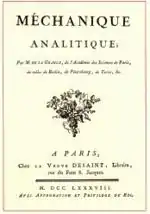Mécanique analytique
Mécanique analytique (1788–89) is a two volume French treatise on analytical mechanics, written by Joseph-Louis Lagrange, and published 101 years following Isaac Newton's Philosophiæ Naturalis Principia Mathematica. It consolidated into one unified and harmonious system, the scattered developments of contributors such as Alexis Clairaut, Jean le Rond d'Alembert, Leonhard Euler, and Johann and Jacob Bernoulli in the historical transition from geometrical methods, as presented in Newton's Principia, to the methods of mathematical analysis. The treatise expounds a great labor-saving and thought-saving general analytical method by which every mechanical question may be stated in a single differential equation.[1]

Lagrange wrote that this work was entirely new and that his intent was to reduce the theory and the art of solving mechanics problems to general formulae, providing all the equations necessary for the solution of each problem. He stated that...[2]
No diagrams will be found in this work. The methods that I explain require neither geometrical, nor mechanical, constructions or reasoning, but only algebraical operations in accordance with regular and uniform procedure. Those who love Analysis will see with pleasure that Mechanics has become a branch of it, and will be grateful to me for having thus extended its domain.
Ernst Mach describes the work as follows:[3]
Analytic mechanics... was brought to the highest degree of perfection... Lagrange's aim is... to dispose, once and for all, of the reasoning necessary to resolve mechanical problems, by embodying as much as possible of it in a single formula. This he did. Every case... can now be dealt with by a very simple... schema; and whatever reasoning is left is performed by purely mechanical methods. The mechanics of Lagrange is a stupendous contribution to the economy of thought.
Publication History
The work was first published in 1788 (volume 1) and 1789 (volume 2). Lagrange issued a substantially enlarged second edition of volume 1 in 1811, toward the end of his life. His revision of volume 2 was substantially complete at the time of his death in 1813, but was not published until 1815.
The second edition of 1811/15 has been translated into English, and is available online at archive.org.
References
- Robert Simpson Woodward, "An Historical Survey of the Science of Mechanics" (Nov. 26, 1894) address to the New York Academy of Sciences, as quoted in Science (Feb. 8, 1895) Vol. 1, No. 6, p. 148.
- Mécanique analytique (1788) Tr. E. W. Hobson, Mathematics, from the points of view of the Mathematician and of the Physicist (1912) an address delivered to the Mathematical and Physical Society of University College London, p.13.
- Ernst Mach, Die Mechanik in Ihrer Entwicklung Historisch-Kritsch Dargestellt (1883, 1888) Tr. Thomas J. McCormick The Science of Mechanics (1893)
External links
- Lagrange, J. L. (1811). Mécanique analytique. 1 (2d ed.).
- Lagrange, J. L. (1855). Mécanique analytique. 2 (3d ed.).
- Lagrange, J. L. (1997). Analytical mechanics. 1 (2d ed.). English translation of the 1811 edition